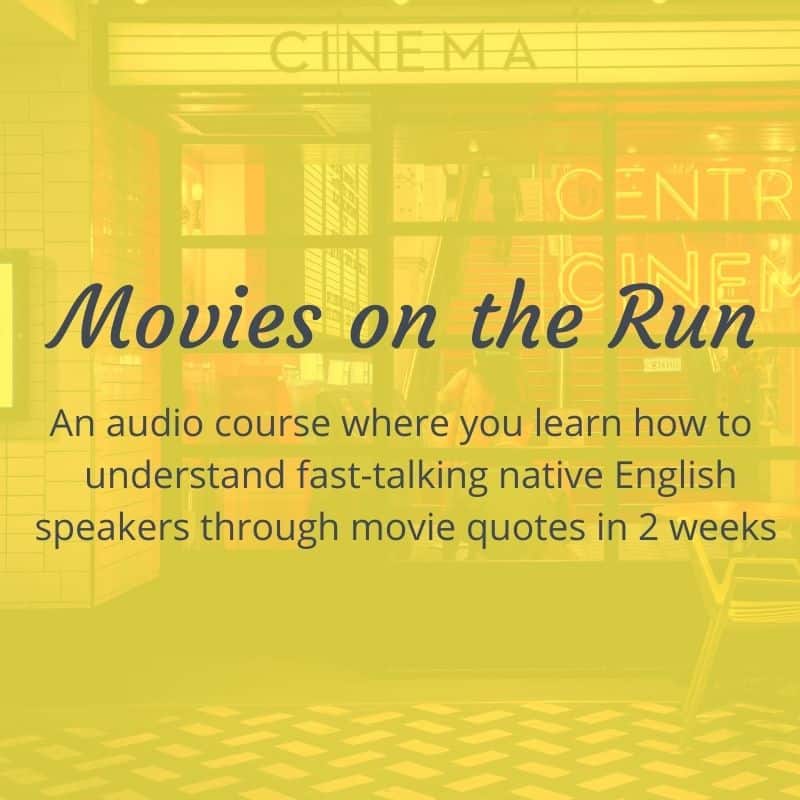The 80/20 Rule For Subtitle Freedom

Do you aim for 100% in what you do?
I’m a recovering perfectionist. I used to want 110%. Not in everything. But in my work and studies, yes please.
Nothing brings out the perfectionist in us perfectionists like learning another language.
And nothing squashes our perfectionism like learning a language. Let me explain.
Do you remember when you were a 3-year old grammar genius?
Probably not. But by age 3 you could create complex sentences in your native language. Even though you weren’t fully toilet trained (or was that just me?).
Then you start learning another language as an adult. And whatever made you a 3-year old grammar genius has abandoned you, leaving you to speak in a broken, mistake-ridden idiolect.
We want 100%. The thing is 100% doesn’t exist. Not even for native speakers.
Linguistic perfection is a chimera (I love that word).
Listen to this article as a blogcast or continue scrolling to read it.

The 80/20 Rule
“80% of success is showing up” Woody Allen
Have you ever heard of the 80/20 rule?
It’s also called the Pareto Principle after the Italian guy who invented it. Pareto demonstrated that about 20% of the Italian population owned 80% of the land.
You can apply this principle to many areas of life and it holds true. The proportions might not always be the same – they could be 70/30 or 90/10 – but the principle remains.
Material possessions
- You wear 20% of your clothes, 80% of the time (this is why I 80/20ed my wardrobe).
Business
- When I was an export assistant, we noticed that around 20-30% of our clients, requested 70-80% of the quotes which meant lots of work for me.
Relationships
- You spend 80% of your time with 20% of your friends and family.
So how can a recovering perfectionist apply this principle to listening?
I usually ask my students to evaluate what percentage of a recording they understood. It’s not an exact science, but it gives me an idea of whether it was a Goldilocks listening or too hard or too easy.
The other day, one of my students told me:
“I think I can guess the general meaning (100%) but I can only pick out around 75% of the words she uses.”
So with 75% of the words, he got 100% of the meaning. That’s the Pareto principle in action.
If you can understand 80%, you’ve got enough to follow the whole series or film.
Once you’ve hit 80% you can turn off the subtitles and use the other clues to fill in the gaps.
- Body language
- Scenery
- Background knowledge
- Lip movements of the actors
You can also stop “reading” the film and start enjoying:
- the camera angles
- the shots
- the locations
- the buildings
- the sexy actors
You can keep the subtitles for the occasional scene that’s tricky to catch and that you think is important to the plot.
80% is a good enough level. By Pareto principle rules, 20% of your efforts, produce 80% of the results. To get the final 20%, you’d need to apply 80% of your effort. Usually it’s not worth it. And no normal human being can get to 100% anyway.
If you want to reach 85%, 90% or even 95% (that may even be a stretch for native speakers) then you can, but you might need a little help. More on that in a second.
If I’m Not At 80% Yet, What Can I Do?
So you’re probably at 50/60/70% – sound about right?
FOCUS
One of the first things you can do is to focus.
As John Lee Dumas says, focus means
Follow
One
Course
Until
Success.
That means you need to choose the series or film that’s your focus. Your favourite that you want to commit to and understand right now.
Cheat A Little
Then you need to make your life easier.
Go to sites like IMDb or Rotten Tomatoes and read the episode or film synopsis.
On the Guardian blog, you can read the episode write-up after you watch to avoid spoilers and to make sure you understood the episode.
Go To The Source Of Your Worries
A student once told me that she watched the Fast & Furious 7, but struggled to understand Vin Diesel.
So that’s your answer right there. Study the scenes with Vin Diesel more closely. Are they important? Why is he so hard to understand?
One of the problems with the Fast and Furious films is that there isn’t too much dialogue – mostly fast cars and fighting (not really my kind of film – sorry!). But stick with me because our man Vinnie is a good example.
I had to search around for a while to find a clip where he says more than one line. Also, I have to search a lot because I get him confused with Dwayne Johnson (aka the Rock) who is also in this film. C’mon they look really similar ok?
All I could find was this slightly freaky scene with Paul Walker – who was already dead at this point, in a car accident in real life (talk about life imitating art!) – and Vin Diesel talking a lot
As you can hear, he has the deepest voice ever and he doesn’t exactly open his mouth much.
Have Some Fun
Accept that you won’t catch everything and that no native speaker will either – this is the essence of the 80/20 rule. Link to why is movie dialogue so hard to understand.
When there are lines that sound like gobbledygook, try pronouncing them after you hear them, even if you’re not sure what you’re saying.
Write out difficult sections and compare with the subtitles. Turn it into a game. Invite a friend over and see how much you can both catch.
Relax, Rewind, Repeat
Listening intensively, doing dictations and pronunciation work helps. But perception is a funny thing and sometimes your mind just needs a rest and a chance to come back to the material.
Give yourself a break and come back to the episode or the clip in a few days. Once your hard work has sunk in, you’ll understand difficult bits more easily.
Beyond 80%?
If you need some more help to hit 80% (or more) understanding for your favourite film or TV show, then I recommend Movies on the Run, an audio course that will help you to better understand fast-talking native speakers thanks to movie quotes.
Until then, keep aiming for 80%. For good enough, not for perfection.

Fed up of watching movies with subtitles?
Feel nervous before you talk to a native speaker in case you don’t understand them?
“Movies on the Run” is an audio course that teaches you 10 English listening secrets that will help you understand native speakers when they talk fast.
Plus, you discover famous movies and the quotes that have become part of everyday speech and culture so you can fit in better. Find out more about Movies on the Run.


Great post! And an interesting spin off is to check and see what you actually understand in your native language. In fact, there’s a good chance you don’t understand everything that was said. . .but it doesn’t bug you so much because you’re better at guessing what you missed! And I have to agree with your evaluation of Vin Diesel–not much of a talker, is he?
Thanks Trisha. Yeah, that’s a great point. We definitely have more resources to fill in the gaps in our native language. We just assume that our perception capacities are 100%, but we’re not as skilled as we believe! Vin Diesel is much more of a fighter than a talker – I think that’s why he doesn’t open his mouth much – to save energy for the fight scenes!
Cara, you know what I’ve been doing with my English speaking students? When they start banging on how little they understand while watching or listening to Italian material, I make them listen to an English track and ask them specific questions about it. They rarely can come up with the correct answer and that makes them understand that maybe they should be a little less hard on themselves.
Then, of course, they forget all about it and start on it all over again, but that’s another story… 😉
People simply seem to enjoy being hard on themselves. Think I’m going to use this sentence for a post of mine!
Great post as usual!
Hi Elfin. That’s a great idea! I have to say that asking comprehension questions about what people watch is a bit odd. Not that I don’t do it sometimes. But it’s pretty unnatural and it does place a heavy load on our memories.
We do ask people to do some weird things in the process of learning languages.
And yes we all tend to be very hard on ourselves – we forget that being “good enough” is great.
I’m looking forward to reading a post from you on that!